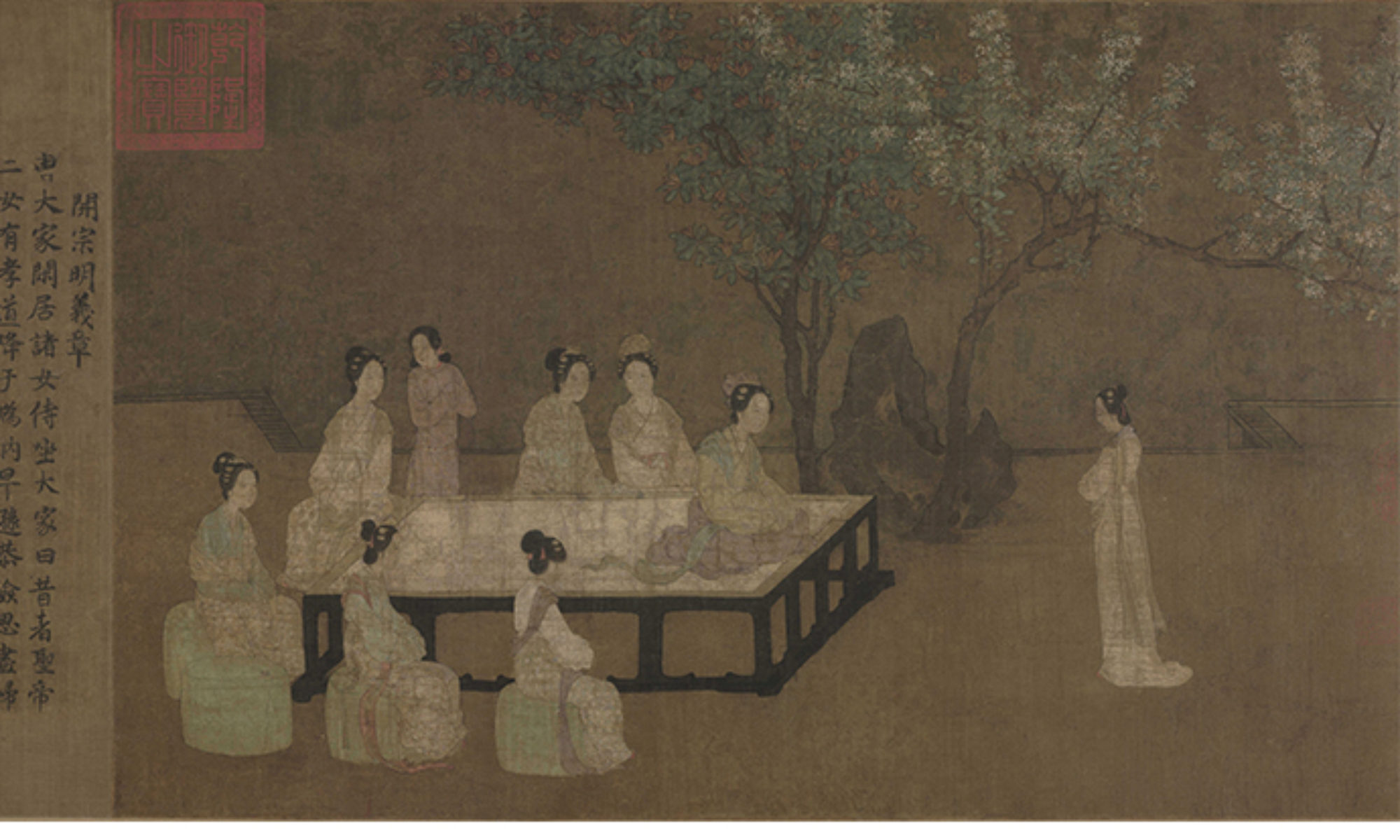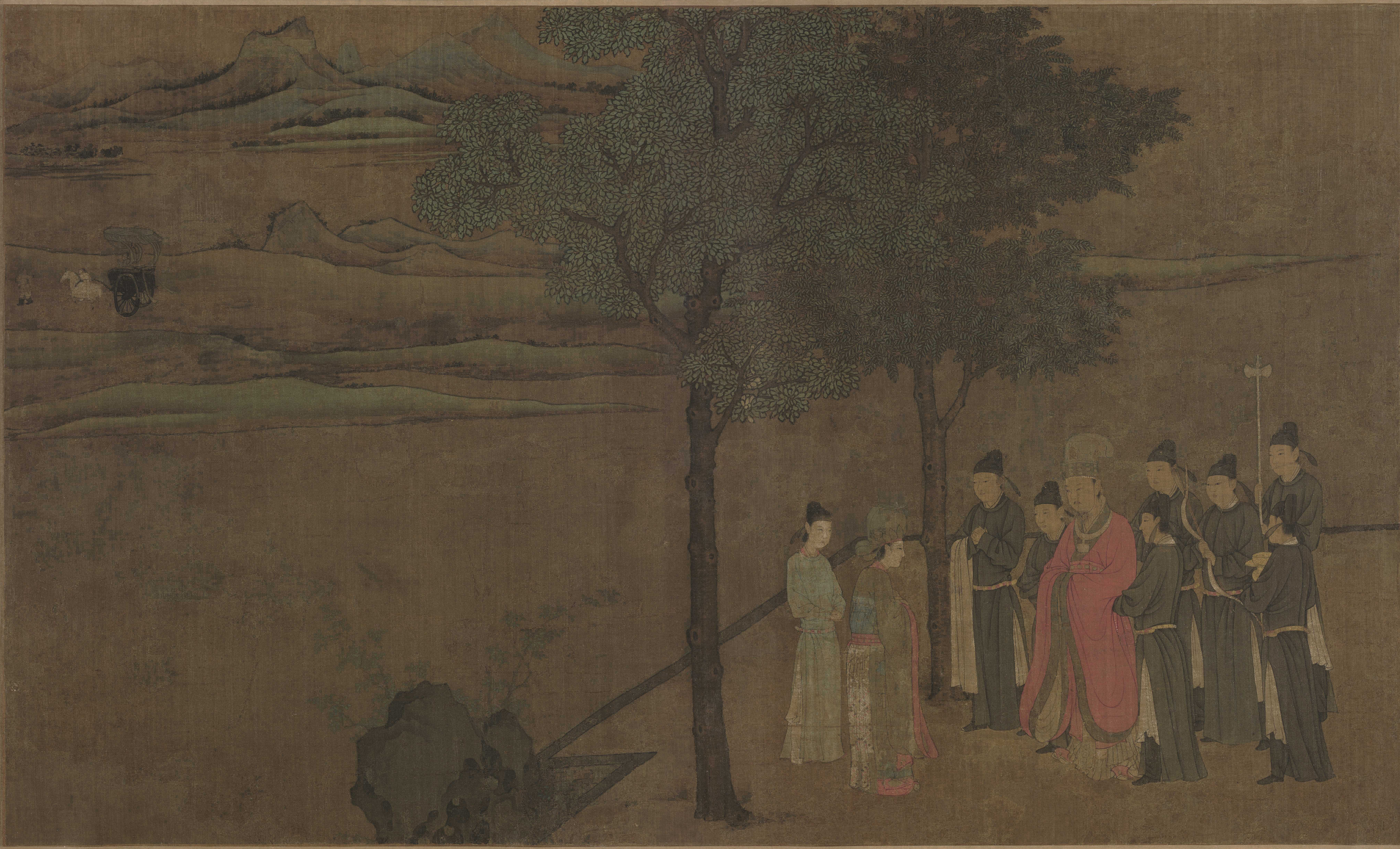In Chapter one and Chapter Four of the Ladies’ Classic of Filial Piety, Madam Cheng described Ban Zhao’s (ca. 45-ca 115 A.D) didactic dialogue with other ladies and Fan Ji’s talk with her husband respectively. The Beijing scroll contains two illustrations of these two well-known model women. As the renowned historical figures, their deeds bore authenticity and thus their virtues were advocated by men to teach upper-class women, which led to their depiction in official didactic works of art. The illustrations of these two chapters are different from the anonymous noblewomen described in other chapters, focusing on the plot of the storytelling and the details of the figures, such as body language, eye contact, and costumes.
In Chapter One, “The Starting Point and Basic Principles,” (Fig. 5.1) Madam Cheng recounted a dialogue between Ban Zhao and ladies. A woman scholar of the Eastern Han period, she was also known by the honorific name of Cao Dajia (曹大家) for her authority on women’s conduct and education. Ban Zhao helped edited the History of the Former Han (Han Shu) along with her brother Ban Gu (32-2 A.D), and she authored the Admonitions for Women (Nü Jie女诫) that consisted of seven chapters of instructions to women on correct conduct as wives.[1] This influential book set forth the basic precepts later adopted by the Ladies’ Classic Filial Piety. As such, Ban Zhao was featured in the first chapter to recognize her contribution.
Chapter One is also combined with the filial deeds of Empresses E Huang (娥皇) and Nü Ying (女英). The inscription is translated below: Ban Zhao was at leisure while the young ladies were seated in attendance. Ban said, “In antiquity, the two daughters of the Sage Emperor (Yao尧) had the filial way and came down to Gui Rui (妫汭). They were humble, yielding, respectful, and frugal; their thoughts were of fulfilling the wifely way. Sagely and wise, they avoided difficulties with others. Have you heard about this?” The young ladies withdrew from their seats and apologized, saying, “We girls are stupid and unenlightened and have not received the rest of your teachings. Could we hear them?” Ban said, “Filiality broadens heaven and earth, deepens human relationships, moves ghosts and spirits, and affects the birds and beasts. Be agreeable, yielding, chaste, and obedient; humane, enlightened, flail, and merciful. When your virtuous acts are accomplished, you will be without blame. The Classic of History says: ‘As for filiality: being filial, and friendly with your brethren’.”
The illustration depicts Ban Zhao sitting on the low platform (ta榻). A group of well-dressed young ladies sat on cylindrical stools; a female servant stood around the low platform. The painter designed this composition of making the ladies surround Ban Zhao to ensure that the viewer would easily recognize the heroine. One woman had left her seat to stand before Ban and bowed slightly in a gesture of respectful inquiry. The ta that she sat on was used as the furniture for sitting and reclining. The garden scene has an ornamental combination of magnolia (Yulan), pittosporum tobira (Haitang), and scholar’s rock, together with some unknown plants and flowers in the farther background. Chen Haozi’s The Mirror of flowers (Hua Jing)[2]in the Qing dynasty noted Yulan symbolizes the quality of nobleness and Haitong flower symbolizes self-esteem and gratitude. Their allegory implies the respect and gratitude of the young women for Ban’s teaching. Also, the flowering Yulan and Haitong suggested that the season was between late spring and early summer in this scene. The painter utilizes the mode of dialogue between female figures to demonstrate the theme of the chapter, and this mode continues to the following chapters. The interaction between the characters, furniture, and matching decorations all visualize the women’s space.
Another model woman featured in the Ladies’ Classic Filial Piety, Fan Ji (active in 6-century B.C.E), is different from Ban Zhao because she was praised as both a moral model and political virtue. Fan Ji was the empress of King Zhuang of Chu (?-591 BCE), who was one of the five powerful kings during the Spring and Autumn period (ca.770-476 BCE). Her story had been widely circulated without being obscured by the reputation of her husband. The Poems of Han (written by Han Ying [ca. 200-130 BC] who was a Western Han Dynasty scholar) described Fan Ji as a frugal and intelligent woman. She had tried her best to persuade King Zhuang not to indulge in banquets and hunting and to govern the state well. At the same time, she also contributed to recruiting wise advisors to serve the King. Such intervention was praised and made her story featured in the chapter “sage intelligence” of the first-century book Biographies of Virtuous Women (Lienuzhuan).[3]
Chapter Four, “Elucidating Wisdom,” depicts Fan’s recommendation of the talented official to the king to emphasize her political wisdom as an empress (Fig. 5.2). The inscription is below: King Zhuang of Chu admired Yu Qiuzi (active in 6 century B.C.E) who is a sage and helps him to govern the country. Fan pointed out, “Yu Qiuzi may be a sage, but he is not loyal. Yu Qiuzi recommends some people into government. However, they are Yu’s sons or relatives instead of recommending other wise men or dismissing unqualified officials.” Fan believes that wise officers should recommend more talented people to King. By contrast, Fan seeks virtuous women in other countries for King Zhuang, instead of her alone to occupy King’s favor. After that, King Zhuang accepted Fan’s advice and sent an envoy to receive Sun Shuao (630-593BCE) and appointed Sun as a minister.
The synchronous composition of this illustration depicts two separate moments. In the background, the carriage hurries to bring the young, talented scholar to the King’s palace. The scene in the foreground represents the next scene. Fan Ji stood before King Zhuang of the Chu, who is surrounded by attendants in men’s outfits[4], to introduce the promising young scholar to him. These scenes are separated by the two trees in the middle of the painting. Fan Ji’s upright yet still respectful demeanor described in the text is visualized by the dynamics between the husband and wife. Instead of lowering her knees, the empress only bows slightly before the emperor, a gesture of her being the equal partner rather than an inferior subject. However, by casting her gaze downward, the painter stayed loyal to the Confucian principle of wives being submissive to their spouses.
[1] Murray, Julia K. “The ‘Ladies’ Classic of Filial Piety’ and Sung Textual Illustration: Problems of Reconstruction and Artistic Context.” Ars Orientalis 18 (1988): 95-129.
[2] The Mirror of flowers (Hua Jing) was written by Chen Haozi (active in the 17th century). The book explained the knowledge about the cultivation of flowers, plants, and farmed animals.
[3] Lienuzhuan (列女傳) is a collection of biographies of eminent women compiled by the Former Han-period (206 BCE-8 CE) scholar Liu Xiang (79-8 or 77-6 BCE).
[4] Murray, Julia K. “Didactic Art for Women: The Ladies’ Classic of Filial Piety” In Flowering in the shadows: women in the history of Chinese and Japanese painting, edited by Marsha Smith. Weidner. Honolulu: University of Hawaii Press, 1990, 41.


